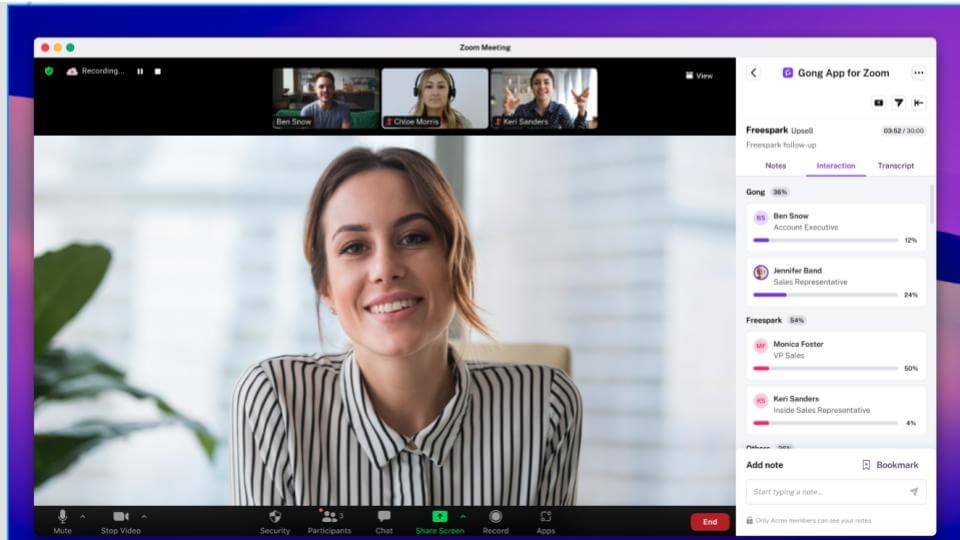Effective sales territory mapping: strategies for optimized market division

[quicklinks links=”prospecting,meetings,discovering,pitching,handling,closing,miscellaneous” labels=”Prospecting, Starting Meetings, Discovery, Pitching, Objection Handling, Closing, Miscellaneous”]
Looking for a rich list of sales tips and techniques you can use to close more deals?
Look no further.
We’ve pulled together a list of 55 sales techniques, tips, and tactics. Many of which we’ve proven with data.
They’re split into sections from discovery call tips to product demos, to objection handling, and more.
Use the quick links on the left to jump to each section.
Let’s get started.
Prospecting sales tips & techniques
Let’s start with PROSPECTING!
This is an essential part of the selling process. After all, you can’t close any deals if you don’t have a pipeline to work with.
There seems to be a ‘cold calling is dead’ trend floating around these days. But fear of cold calling is only going to hold you back. Valuable enterprise buyers don’t come “inbound” often. You, the sales professional, have to hunt them with outbound prospecting.
No cold calling is BAD.

BUT, prospecting is more than memorizing a cold calling script. Or making hundreds of dials a day hoping that someone agrees to meet with you. It’s more than a mindless numbers game.

It’s all important. One approach isn’t better than the others. The power comes from the combination.
Art and science are both essential to GREAT prospecting.
Now, we like to think we’re pretty good at prospecting here at Gong, so many of these sales techniques and tips come from experience.
Let’s go.
PS: Before you read on, get our FREE cold calling cheat sheet.
It’s PACKED with useful sales techniques and tips that will help you book more meetings:
1. Buy as much time as possible
When your buyer answers your call, you have 5 seconds to earn 5 minutes.
Successful cold calls are almost twice as long as unsuccessful cold calls. The longer the call, the greater your odds of getting the meeting:

Your job isn’t JUST to get your prospect’s attention – it’s to hold it.
And here’s your advantage: You’ve had this same conversation hundreds of time. You can predict the conversation “paths,” and how to navigate each one. You have the power to plan every move you’ll make in advance.

Every sentence you utter should get the buyer to listen to your next sentence.
That means you have to be economical and compelling with what you say.
Here’s how to be economical: Pretend you get $100 to remove any unnecessary word from your script. Which ones would you remove? Gut those.
The rest of this section will show you how to be compelling.
2. State your full name, and company name
When you make a call, here’s a key sales tip: State your full name and company name upfront.
It sounds like this:
“Hi John, this is Chris Orlob calling from Gong.io…”
Why do this?
Two reasons.
FIRST, important people state their full name.
The next time you meet someone new, see if they introduce themselves by stating their full name.
If they do, I’m willing to bet that your respect for them jumps up a notch.
People who introduce themselves with their full name command respect.
SECOND, you control the conversation when you state your name and your company’s name up front.
Write this down:
The person who asks the questions controls the conversation.
And what happens when you don’t give your name and company name upfront?
Your buyer asks “Who is this?” or “What company are you with?”
Now you’re put on the defensive.
Not good.
3. Don’t ask “Did I catch you at a bad time?”
This is a common way new reps use to open a cold call.
Hi John this is Chris Orlob with Gong.io. Did I catch you at a bad time?
Many sales books recommend this opening line.
Here’s the theory behind it:
People like to say “no,” so they can feel in control.
And when you ask, “Did I catch you at a bad time,” they want to say, “No.”
It opens the door to a successful cold call.
Sounds good in theory, right?
But, in our analysis, opening your cold call with “Did I catch you at a bad time” makes you 40% less likely to book a meeting:

Cold calls that opened with this line had a dismal 0.9% success rate.
Here’s what to do instead.
4. Do ask “How’ve you been?”
This sales technique tip will make old-school sales trainers cringe.
Once you’re into the prospecting call, open by asking:
“How’ve you been?”
So, your first-five-seconds script should sound like this:
“Hi John, this is Chris Orlob with Gong.io. How’ve you been?”
We have data that shows that this is the most successful cold call opening line:

It performs 6.6X higher than cold calls that don’t include it.
I know what you’re thinking.
“Wait a sec! They’re asking how they’ve been … that implies they know the person! Doesn’t that explain the success rate?”
Negative, ghost rider.
The data set we tested was only calls that were first interactions.
The reason this question works so well is that it’s a pattern interrupt.
It’s unexpected. It “scrambles” your prospect’s brain (in a good way).
Give it a try, and you’ll see that there’s nothing to fear.
5. Immediately state your reason for calling
State the reason for your call as soon as your buyer responds to the previous sales method.
Humans crave reasons and want to know why things are the way they are. Receiving an unexpected call is no exception.
Our research shows a 2.1X higher success rate for salespeople who state their reason for calling:

As soon as they answer the phone, your buyer’s mind will race, wondering why you’re calling.
Put that question to rest with this script. Say it all together now:
“Hi John, this is Chris Orlob with Gong.io. How’ve you been? [Good… ] John, the reason I’m calling is …”
And then give your reason.
It’s such an EASY sales technique tip. TRY IT!
6. Do your account research
I wanted to start the prospecting section with this sales method, but I was afraid that you’d roll your eyes and close it immediately. You’re probably tired of hearing the same old “personalize your message!” and “do your research!” advice.
But now that you’ve read the first five sales tips, I hope that you’ll give me a chance to expand on this one.
If you work in B2B sales today, you HAVE to know who you are going after. And with all the tools available to you, there’s no excuse for going into a cold call blind.
LinkedIn makes this easy.
For example, when our sales team prospects, they need to know how many sales professionals work at the account they’re prospecting into.
Our salespeople search for the company on LinkedIn, and learn more about the account:

They see a wealth of information: growth rates, employee count, even the number of employees in sales:

This gives our reps the “ammo” they need to predict this company’s pain points.
For example, if they’re growing fast, they probably have a sales onboarding challenge.
That’s a compelling business development problem we can address.
That kind of information helps you tailor your messaging when you reach out.
7. Do your personal research
I don’t need to beat a dead horse, do I?
If you use LinkedIn to look up account information, do the same thing for the person you’re contacting.
You’ll learn things from their profile that you may be able to use when you contact them:

For example, if I were targeting ^ that good-looking dude, I would use some of his language in my outreach.
Imagine an email subject line that said:
“Win the unfair share of your market”
Given that it’s unique and visceral language that’s specific to him, it’ll resonate.
8. Avoid too much discovery early on
“Listen twice as much as you talk” doesn’t apply to cold calling.
Cold calling isn’t about discovery – it’s about selling the meeting.
In fact, the talk-to-listen ratio for successful cold calls is HIGHER than unsuccessful ones:

It’s your job to sell your buyer on why they should attend the meeting. You can get into asking about their “top strategic priorities” later when you book the meeting.
Think about it…
Have you ever tried asking “What are your top priorities…” at the outset of a cold call? I bet you didn’t get much of an answer. That’s a good sales method used at the wrong time.
Focus on selling the meeting, not on asking a probing question your sales manager would be proud of.
9. Pitch a targeted value prop
If you’ve followed the previous sales techniques and tips, you’ve secured a platform to make your sales pitch. It’s your time to sell the meeting.
Successful cold calls ALMOST ALWAYS involve making such a sales pitch:

I know, I know. “Pitch” seems to be a bad word in sales today.
But there’s a time and place for them. Midway through a cold call is one of them.
So what do you SAY during your sales pitch? You SELL THE MEETING, not your product.

let’s break that down.
Talking about their competitor is SURE to get them to snap up and listen.
After that, I delivered an insight related to their pain point. That by itself is often enough to sell the meeting (they want to know more).
To top it all off, I melted away any possible resistance with the phrase:
“…You can judge that for yourself.”
THAT is what I mean by “selling the meeting.” Notice there was no mention of the product.
10. Book the meeting with this closing question
Alright… You’ve done your research. You’ve opened the call. You’ve sold the meeting. Your buyer’s interest is at its peak.
GREAT!
Now get that meeting scheduled! Here’s your magic sales tactic to do it.
After you’ve made the suggestion for the meeting (see the previous step), finish off with:
Do you have your calendar handy?
It is by far the best closing technique for a cold call I’ve ever seen.
Works like a charm.
. . .
Now let’s SOLIDIFY your new prospecting skills. Download our FREE cold calling cheat sheet.
Save it to your desktop and take a quick look at it before you make your next cold call.
Sales tips & techniques for starting meetings
Prospecting sales techniques… DONE!
Now it’s time to make sure all those meetings you booked go well. :)
Opening a sales meeting is both an art and a science. And so many sales professionals overlook the TACTICS involved. They waltz in and start blabbing.
But as you’ll see, there are sales techniques and tactics you can use early on to help the rest of the sales meeting unfold persuasively.
Here they are.
11. Prepare for your call in advance
Great salespeople don’t wing it. They’re intentional. They’re cerebral. Dare I say, they’re STRATEGIC. They plan their moves in advance.
Here’s the data to support that.
Top-producing salespeople progress through their sales calls sequentially, not haphazardly. When you analyze the topics they discuss, they move from topic to naturally-related topic.
And as you can see in the GIF below, average performers DON’T structure their calls in a systematic way. They bounce around from topic to unrelated topic:
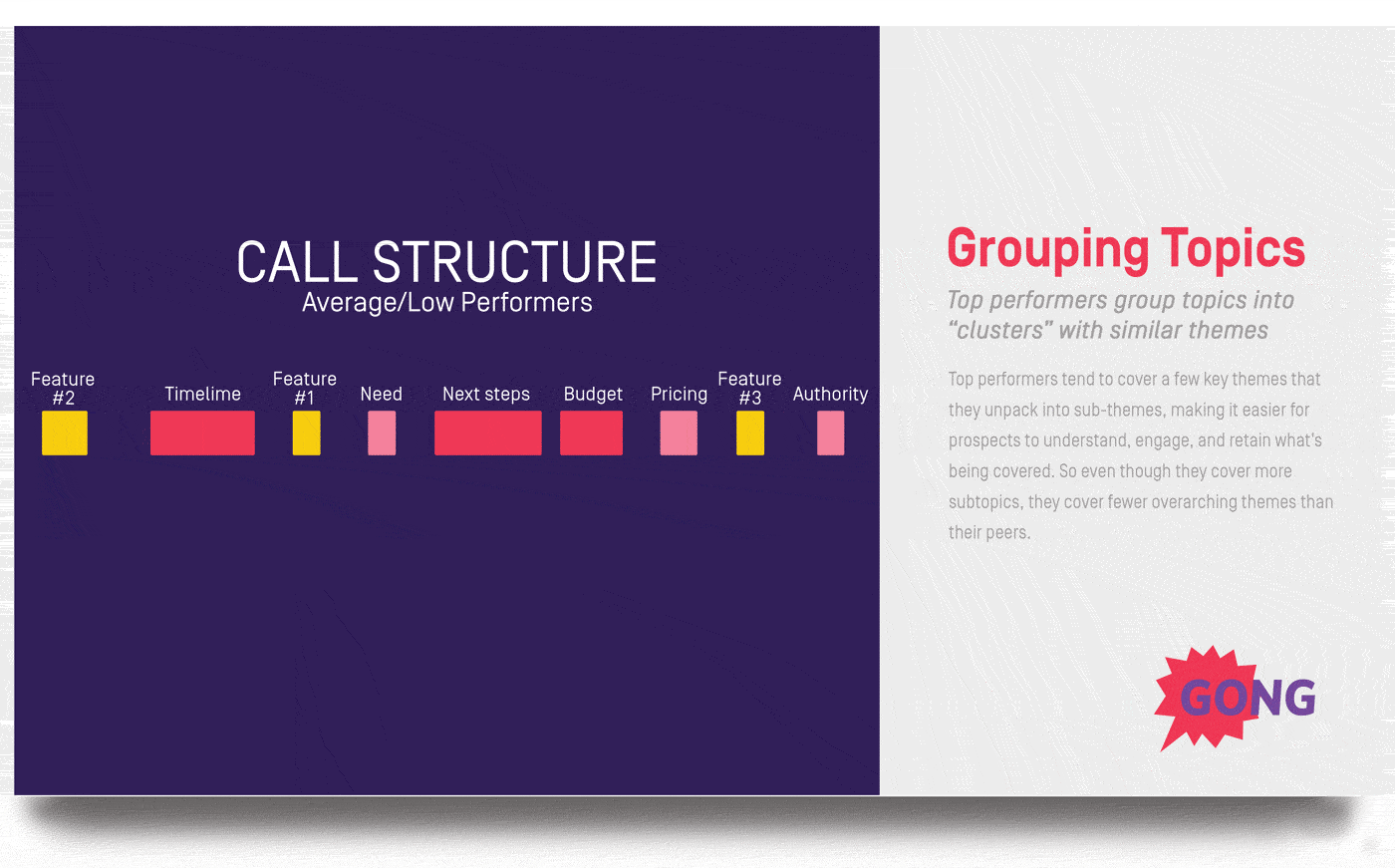
Do the same. Plan your sales methods in advance.
PS: Download our FREE sales call prep checklist below. It’ll help you knock EVERY meeting out of the park:
12. Start Your Meeting with an “Upfront Contract”
There’s one simple sales method you can use to take immediate control of a meeting.
Set an “upfront contract” near the beginning of the meeting.
The folks at Sandler Sales Training invented the upfront contract. Here’s what they say about it:

In other words, at the beginning of the sales meeting, get agreement from your buyer in advance on:
- The meeting’s purpose
- The buyer’s agenda and expectations
- Your agenda and expectations
- The amount of time set aside for the meeting
- The meeting’s intended outcome
In a real sales call, that might sound like this:
“By the end of this call, I’d like you to be in a position where you’re either interested and we plan the next step, or you’re not interested, you tell me that, and we avoid wasting time. Is that fair?
“Now to achieve that, I have 30 minutes set aside. Do you have any hard stops coming up that I should know about?
Great. I plan on covering A, B, and C. Is there anything you want to add or remove from that agenda?
Sounds good! Let’s get started.”
Try it. This sales technique works wonders for setting the sales meeting’s tone.
13. What’s changed since the last time we talked?
OK, so you’re having the second, third, or FOURTH meeting with your buyer.
GREAT.
Be sure you start those meetings as tactically as you started the first one.
Here’s one of the first things to ask:
“What’s changed since the last time we talked?”
Buying and selling is a complex process, and change tends to interfere with things more than we’d like. If you don’t stay on top of what’s changing in your buyer’s environment, your deal can “go dark.”
For better or worse, the answer to this tells you KEY information that will help you close your deal.
Discovery sales tactics & techniques
An effective discovery call is the starting point for any successful deal.
Why? Because if you don’t know your buyer’s needs and pains, the rest of the sales process will be guesswork.
That’s no way to run a sales process.
Follow the proven discovery call tips below to get started!
Be sure to download our discovery call cheat sheet. You’ll have DEAL-CLOSING discovery calls!
14. Turn on your webcam
Why is this a discovery call tip?
Because it’s more important to turn on your webcam during discovery calls than during other types of calls.
Why? Because other types of calls already have a visual backdrop for the conversation:
- Demo calls have a product demo
- Presentations have a visual slide presentation
- Etc.
But often, discovery calls are mano y mano: you and the buyer. If you don’t have your webcam on, the buyer has nothing to look at and is far more likely to grow fatigued by your questions.
There’s data behind this.
Closed deals involve using webcams 41% more often than lost deals:

(Curious about where this data comes from? Check out this post on using video in sales).
When your buyer sees your face, the discovery call becomes conversational. You avoid the interrogation trap.
It helps your buyer see your questions as driven by curiosity, rather than checking boxes.
There’s an art to having great video calls (and lots of mistakes to avoid).
Download our free, 9-point checklist for having great video sales calls:
15. Ask questions that invoke long answers
The point of a discovery call is to understand your buyer’s needs and tailor the rest of the sales process.
But sometimes your buyer doesn’t give you enough to work with. (We all dread one-word answers to our questions.)
There’s even a direct correlation between your odds of closing a deal and the length of your buyer’s response to questions:

The longer the “customer story” (i.e., the length of the buyer’s response), the higher your odds of:
- Advancing the deal to the next stage
- Closing the deal
In other words, you want your conversation to look like this:

How do you do that?
Here’s a game-changing sales techniques and tips for getting long responses to discovery questions:
Phrase your questions in a way that encourages a long response.
You’re probably used to the standard who, what, when, where, why, and how questions. The problem is, those standard questions get standard responses.
Instead, start your questions with one of these phrases:
- Can you help me understand …
- Can you walk me through …
- Can you talk to me about …
- Can you tell me about …
“What’s your biggest challenge” becomes “Can you help me understand your biggest challenge?”
This subtle shift in phrasing signals that you want your buyer to answer you in depth.
Use this phrasing, and you’ll receive rich answers that will help you navigate the rest of the sales process.
Measuring the length of your buyer’s answers is super easy with the stats tab in Gong:
Stats >> Interaction >> Longest Customer Story

16. Ask questions only an expert could ask
You know the saying, “there’s no such thing as a dumb question?” It doesn’t apply in professional selling!
There are plenty of dumb questions, many of which can destroy credibility with your buyer.
The best question you can ask is one that only an expert would think to ask. These types of questions make your buyer think rather than recite information. They signal to your buyer that you’re a competent professional they can trust.
Here’s an example.
When I worked at InsideSales.com, I used to ask this question within the first few minutes of a call:
“Can you walk me through your sales process, from when you first generate a new lead, all the way to a closed deal?”
The wording of that question matters. It signals a level of seriousness and competence. It signals that you’re about to dig deep with your buyer.
Compare that question with the trite, “What’s your sales process?”
Even though they ask the same thing, one shows expertise, while the other shows a sophomoric lack of preparation.
17. Ask the right number of questions
It turns out there’s a sweet spot for how many questions you should ask during a sales call.
For introductory discovery calls, that number is between 11 and 14:

Too many questions and the conversation will feel like an interrogation. Too few, and you won’t unearth enough information to guide the rest of the sale.
Find out how many questions you (or your sales professionals) ask on average using Gong Stats:
Stats >> Interaction >> Question Rate

And what sort of questions should you ask? There are dozens of sales methodologies, but in general, your questions are best pointed toward business problems or opportunities:

(To learn more about this data, read this post on discovery calls).
WARNING: When you sell to a C-suite executive, they’re a different animal. They have little patience for generic questions.
When you’re selling to a C-level executive, your win rates decline after a small handful of questions:

In fact, successful meetings with C-suite executives have only four questions on average. Unsuccessful meetings have eight:

Senior executives, more than other types of buyers, have “discovery fatigue.” By the time they have a meeting with you, they’ve likely been through 2 or 3 discovery calls with other sellers. Answering all those questions feels taxing.
So what should you do when selling to a C-suite executive?
The answer goes beyond the scope of this post. We’re not just talking about c-suite sales techniques here. But you can learn all about how to sell to the C-suite here.
And to get a university-level education on selling to the C-suite, watch this FREE training video – Selling to the C-Suite:
18. Base each question on what your customer just said
Most of your questions should spring spontaneously from what your buyer just said.
That’s how to make your discovery calls conversational. It’s what highly successful salespeople do.
Average salespeople don’t do that. Their buyer’s responses don’t influence the questions they ask. Average sales professionals have a standard list of questions, and they ask them like they’re working their way through a checklist, as illustrated by this chart:

The top performers balance their questions through the call, while average reps front-load their questions at the beginning as if they’re completing a to-do list before launching into their pitch.
In great discovery calls you’ll spread questions evenly like they are in this Gong call recording:

Ditch the script.
Ask most of your questions as a follow-up or drill down into what your customer said. A simple dialogue might look like this:
- Sales professional: Can you help me understand where deals stall out most often in your sales process?
- Buyer: It’s usually after they see a product demo. The buyer gets all excited by the demo, but then they have the daunting task of getting their VP scheduled for a call with us. They tell us they should have “no problem” getting that meeting scheduled. Weeks go by, we follow up a handful of times, and never hear back.
- Sales professional: Interesting. What would you need to change to prevent that from happening as often?
This is an oversimplified conversation, but it illustrates the point: The sales rep’s second question doesn’t start a new thread. It goes deeper into an issue the buyer raised.
19. Maintain a healthy talk-to-listen ratio
On average, the top producing salespeople have a 46:54 talk-to-listen ratio during their discovery calls. That means they talk for 46% of the call and allow their buyer to talk for the remaining 54%:

This sales tip is so obvious that it should be the first tip listed in this section. So, why isn’t it? Because it’s a byproduct of doing everything else right.
Think about it: Talking for 46% of a call isn’t going to magically help you close deals. But when you do the other sales techniques and tips included in this post, you’ll end up with this ratio (more or less).
You can measure your talk-to-listen ratio in seconds with the Gong Stats page:
Stats >> Interaction >> Talk Time
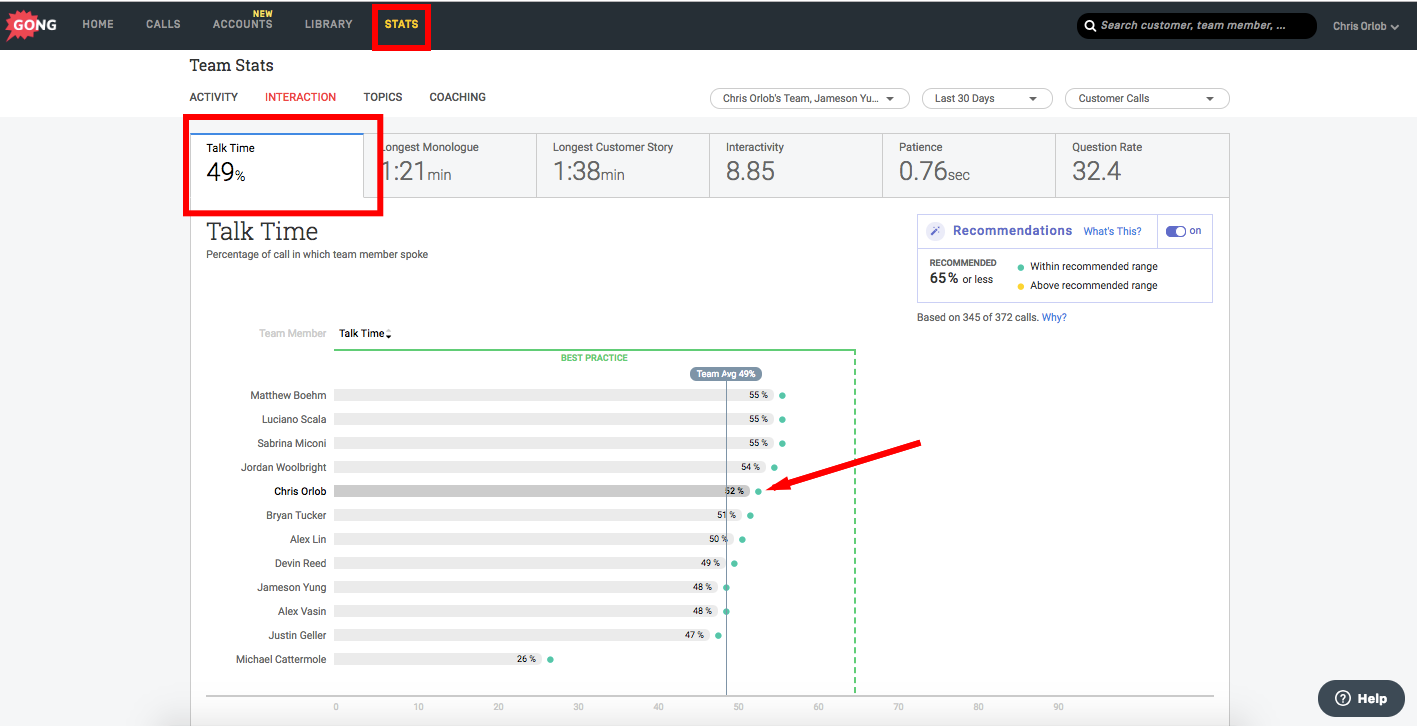
Here are a few more sales techniques and tips that will get your customers talking more.
20. Mirror the buyer’s most important 1-3 words
Here’s the best way to get your buyer TALKING:
- Repeat the 1-3 main words from their statement
- Do so with an upward voice tone that suggests you’re asking a question
It might sound like this:
- Buyer: We have a hard time differentiating from our competitors. Our product is strong, but our reps tend to back peddle when customers ask how we’re different.
- Sales professional: Back peddle?
- Buyer: Exactly. They don’t respond with a crisp, strong answer. Instead, they stumble through, and the team is inconsistent with how we answer.
- Sales professional: Inconsistent?
- Buyer: Yeah, that’s a bigger problem we’re dealing with that goes beyond differentiating. I have 70 sales reps handling their sales calls in 70 different ways. Everyone is telling a different narrative and running their process in different ways.
The beauty behind this sales technique tip is that your buyer becomes EXTRA likely to expand on their point. That’s because you’re relaying their own words back to them (and everyone loves their own words).
Contrast this approach with asking “Can you expand on that point?”
That might work, but it can feel a bit like a pickaxe. Repeating THEIR words eliminates friction.
Check out more of Chris Voss’s sales tips and negotiation techniques in this video:
Want to up your negotiation game? Get our 11 negotiation techniques to master the #1 skill in sales.
21. Use this sentence to label your buyer’s emotions
This next sales technique, which Chris Voss calls labeling, is empathy on steroids.
When you notice your buyer express an emotion, label that emotion by completing one of these sentences:

The “blank” should be an accurate label of the emotion you just observed your buyer express. It might sound like this:
- Buyer: It’s labor-intensive for us to onboard new sales reps. Creating the training material is bringing our enablement department to its knees.
- Sales professional: It sounds like you feel overwhelmed every time a new onboarding class starts.
If you’ve accurately labeled the emotion, you’ll get a rich response. The key is to shut up after you’ve offered a label. Let your buyer talk uninterrupted, which is the subject of our next sales tip :)
22. The awkward pause sales tactic
This sales tip is not for the faint of heart.
If I had a dime every time a sales professional started talking before the buyer finished their response, I’d be living in my dream home in Santa Barbara.
But alas, I failed to convince my boss to compensate me in such a way.
Pause for three long seconds after your customer has finished talking (or after you’ve done one of the above sales techniques). It will amplify the other sales techniques and tips in this article.
Humans have a tendency to fill the silence in the conversation. If you hold off from talking for a beat longer than what feels natural, your customer will continue to talk. They’ll often reveal key pieces of information that can help you close the deal.
Listen to the CEO of Gong.io talk about his success using “the awkward pause” (plus, a bunch of other useful sales tips):
23. Summarize what you heard to get a “That’s right!”
I’m going to let you in on a secret. Humans go through 95% of their lives feeling misunderstood. Most of the time, we’re denied that gift.
If you can show them that you understand them, you’ll blow them away.
LISTEN to your buyer’s fears and frustrations. Then, end the call by summarizing what you heard in their words. They will emotionally lean toward you in amazement (though they will never admit it).
In fact, this sales technique tip is so important, that the Solution Selling methodology dedicates three of its nine types of discovery questions to summarizing confirmations:

If you get this right, it might be the first time in their lives that many of your buyers feel truly understood by another person.
That’s how rare this is.
Here’s how this technique works.
At the end of your discovery call, say this:
“Let me summarize what I’ve heard from you so far …”
Then, spend the next half-minute or so relaying what you heard in the words they used.
And finally, cap it off with this phrase:
“Did I get that right?”
Again, if you listen and summarize what you hear, they will emotionally “sigh” in relief.
WIN!
. . .
STOP!
You’ve gone too far…
… Without downloading the FREE discovery call cheat sheet.
You’ll thank me later:
Sales pitch techniques
The word “pitch” tends to get a bad rap these days.
But that’s only because so many sales professionals skim over doing great discovery!
Assuming you DON’T make that mistake, pitching is an important (and high-income) skill.
And eventually, you have to make a pitch during the sales process. You might not use the word “pitch,” but it’s all the same: Delivering a compelling narrative that gets a prospect to BUY.
Here’s how to do that.
24. Send a copy of your pitch deck before the call
Did you recoil with a jolt? Yeah, that happens.
For some people, sending their pitch deck out before a call is like revealing all the secrets in advance of the magic show. But trust me, it’s a good move.
It lets you open the call with this question to see if they were paying attention:
“Based on the information in the deck I sent, where should we start?”
If they didn’t review it, that could be a sign … but not always, so don’t let it get you down. Start where you normally would. Nothing lost, nothing gained.
On the other hand, if they do have questions ready to go, you’ll head straight for a top-tier discussion. You’re playing ball with someone who is ENGAGED.
25. Invoke self-discovery
Most salespeople center their pitch around:
- Benefits
- Outcomes
- Desired results
Big mistake.
For benefits to resonate, you have to sell buyers on a problem (i.e., get them to admit to it). The best way to achieve that is to invoke self-discovery.
Get your buyer to self-identify with the problem your solution addresses.
Here’s the rule to follow (you may want to write this down on a sticky note):

AUTOMATICALLY.
Alcoholics Anonymous executes this “sales techniques” better than anyone. Here’s a testimonial you WON’T see on their website:
“AA changed my life! My career is back on track, and my family life is better than ever!”
No no no! They don’t lead with the end-result in their messaging.
Why won’t that work? Because they have a “ customer base” that is in DENIAL: Alcoholics who have not admitted to having a problem.
What does AA do instead? They use testimonials that voice the PROBLEM in a way that resonates with readers. They sound like this:
“It started with a few drinks on the weekends.
That led to a few drinks every night.
Before I knew it, I couldn’t kick the habit. My relationship with my wife started crumbling, and my kids avoided me at night.
That’s when I knew something had to change.”
OUCH.
Now if you have a potential drinking problem, THAT message is going to make your heart sink a bit (in a good way). You’re going to “see yourself” in the story.
That’s what it means to invoke self-discovery.
If you can get your buyer to SEE themselves in a story, they will come to their own self-discovery about the problem.
26. Focus your message on Point A (THEN Point B)
This sales technique is HIGHLY connected to the previous sales tip.
You can think of every product in terms of getting your buyer from Point A (the status quo), to Point B (the desired outcome).
Of all sales messages, 95% focus on how GREAT point B is, rather than addressing how PAINFUL point A will continue to be.
Done right, focusing your message on the pain of Point A is EXPONENTIALLY more powerful.
Why? It’s called loss aversion.
Loss aversion is the principle that people will work 2X as hard to AVOID LOSS as they will to GAIN BENEFITS.
When you can tell a story that highlights the pain of “Point A,” you trigger loss aversion. Loss aversion creates URGENCY.

This is the “secret tactic” of deal-closing sales pitches.
They focus on pain and external trends that are about to make the status quo even more painful.
Then (and only then) should you introduce benefits. And since you’ve built urgency, the benefits will have a fertile landing pad. They’ll be MUCH more likely to resonate.
27. Lead with insight
Buyers want you to educate them. They want to deal with salespeople who make them think differently about a problem or opportunity.
They don’t need you to prattle on about product benefits. A brochure will do fine, thank you.
This TaylorMade video is a GREAT example of leading your sales pitch with an INSIGHT. Insight that leads TO your product’s strengths:
The video teaches you how to get greater distance in your golf swing in a way that connects with the product’s unique strength.
They don’t lead with their product, they lead with insight. That insight changes how buyers think about the problem their product solves.
28. Lead TO your differentiators (not WITH them)
Explaining how your product is unique means nothing if buyers don’t value that difference.
So how do you make them value your unique strength?
Here’s a competition-crushing sales technique for you:
Educate the buyer on a problem or opportunity they’ve (so far) undervalued; one that leads to your differentiation.
Here’s an example we use at Gong.io.
Our sales reps start by educating the buyer about a problem (that only we happen to solve):
The delta between their top producers, and everyone else:

Once they frame the problem, our reps educate the buyer on the URGENCY of the problem.
Overachievement from your best reps is great!
But it’s canceled out by everyone who misses quota.
You’re left breaking even at best or missing your number at worst.
Only NOW do we introduce a key differentiator:
We’re the only platform that shows you what separates your best reps from the rest …the questions they ask, what they talk about (and when), etc.

See the difference between leading TO your differentiator versus leading WITH it?
If that pitch had STARTED with the differentiator, it might not have landed.
When you teach your buyer about the problem you uniquely solve, you’re SELLING, not guessing :)
29. Use executive-level language
Your language will get you delegated to the person you sound like.
Let’s repeat that:

If you spout specs and features, you’ll get PUNTED down to the person you sound like.
“This is great! But you know who’s in charge of this stuff? Our IT guy.”
~ Senior executive you just blew your chances with
Instead, tie your value prop (and language) to STRATEGIC issues.
Talk about higher-order business problems and strategic opportunities:
- The competition
- Market dynamics and market share
- Trends
That’s how you sell to the C-suite.
PS: Get your FREE video training on selling to the C-suite by clicking the banner below:
STOP RIGHT THERE!
Sign up for that webinar above. I’m telling you. It’s RICH with amazing sales techniques and deal-closing sales tactics.
30. Flip your pitch upside down
Most salespeople do their pitches in a LOGICAL ORDER, and it leads to EPIC failure.
Let’s say you’re pitching some politician on building a new CITY.
Most salespeople would approach that pitch in this logical (but ineffective) manner:
Ms. Politician, we start with this empty plot of land:

It doesn’t look like much yet. BUT JUST YOU WAIT!
In a few years, we’ll have some roads, sidewalks, trees. Maybe we’ll even have our first stoplight!

Bear with me! We’re just getting to the good part …
A few years later, we’ll have residences and even a few local businesses! Maybe Wal-Mart will move in.

Our burgeoning city will keep chugging along, reaching new heights of metropolitan greatness.
After a decade or two, we’re going to have ourselves a thriving, BEAUTIFUL city, rivaling Manhattan!

Let’s unpack that for a minute.
The seller thought he was doing it right by building anticipation and leading up to the grand finale. It was a “ logical” pitch.
But Ms. Politician is busy, and it took 30 minutes to get to the point. All the while, Ms. Politician had been impatiently waiting to see what the rep was getting to.
Let’s start over and hear what a GREAT pitch sounds like.
Ms. Politician, we have a bold vision for a new city. We’ve worked on the plans, and if we follow them, it will look like this:

I’m happy to walk you through our plans at whatever level of detail you’re interested in.
See how different that is?
The second pitch sold the buyer on the END RESULT, right up front. It started with the outcome and let the conversation unfold from there.
We saw this pattern of winning product demos in our data analysis.
Effective demos START by mirroring the priorities you discussed during the discovery call:

The first part of your pitch should match the problem you spent the most time on in discovery.
The second part of your pitch should match the problem you spent the second most time on.
Etc.
We call this process solution mapping.
Most people think it’s good to save the best part for last. They think they’re building value. But they’re not. They’re DESTROYING it.
The part of your pitch you were saving for the end? Start with that.
31. Break up your pitch so it’s a conversation
When you DO “pitch” during the sales process, it’s better to turn your pitch into a two-way dialogue.
Here’s an example of a one-way pitch, which you want to AVOID:

The talk-to-listen ratio is terrible. The rep wasn’t listening enough (or asking the right questions).
Equally important: there are LOTS of long “monologues.” They aren’t broken up into two-way conversation.
By contrast, here’s what a GREAT pitch looks like:

Now that’s a robust conversation.
32. Never present for more than 9 minutes at a time
Speaking of ways to make your pitch more appealing to your buyer:
Keep your sales pitch to NINE MINUTES.
Our data shows that lost deals have presentations that lasted 11.4 minutes (on average).
What’s the problem? Our brains tap out at the nine-minute mark:
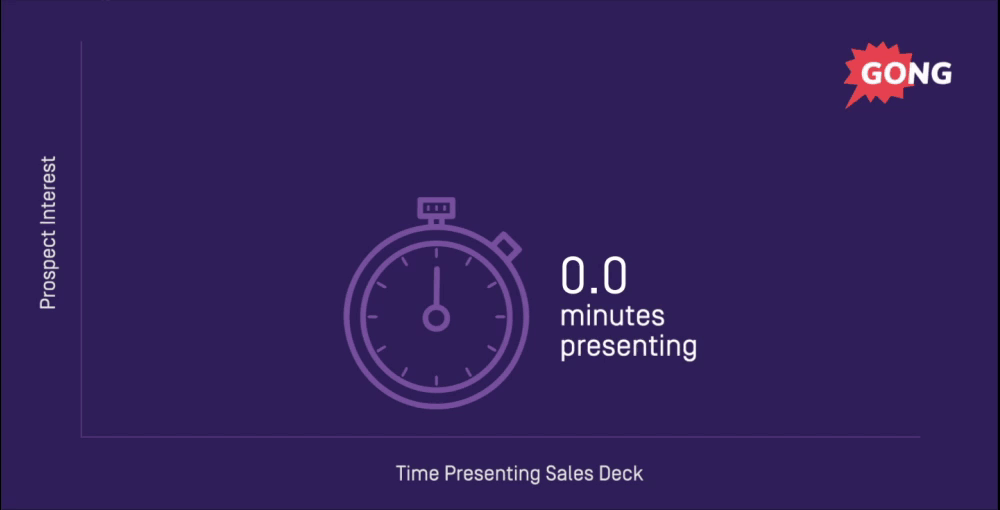
When you hit that magic number, it’s time to CHANGE GEARS.
Switching speakers is a great way to bring your buyer’s attention back to the conversation. And you can do that through a different speaker, video, or demo.
Once you’ve got their attention again, stick to the 9-minute rule!
Never let any segment of your pitch last longer than that, or you’ll risk losing your buyer’s interest for good.
33. Use TRIBAL (not generic) social proof
Social proof will BACKFIRE if your buyers don’t identify with the clients you brag about.
In fact, salespeople who use generic social proof have a 22% lower close rate:

If you use it in early stage calls, it’s even worse! Close rates drop by 47%:
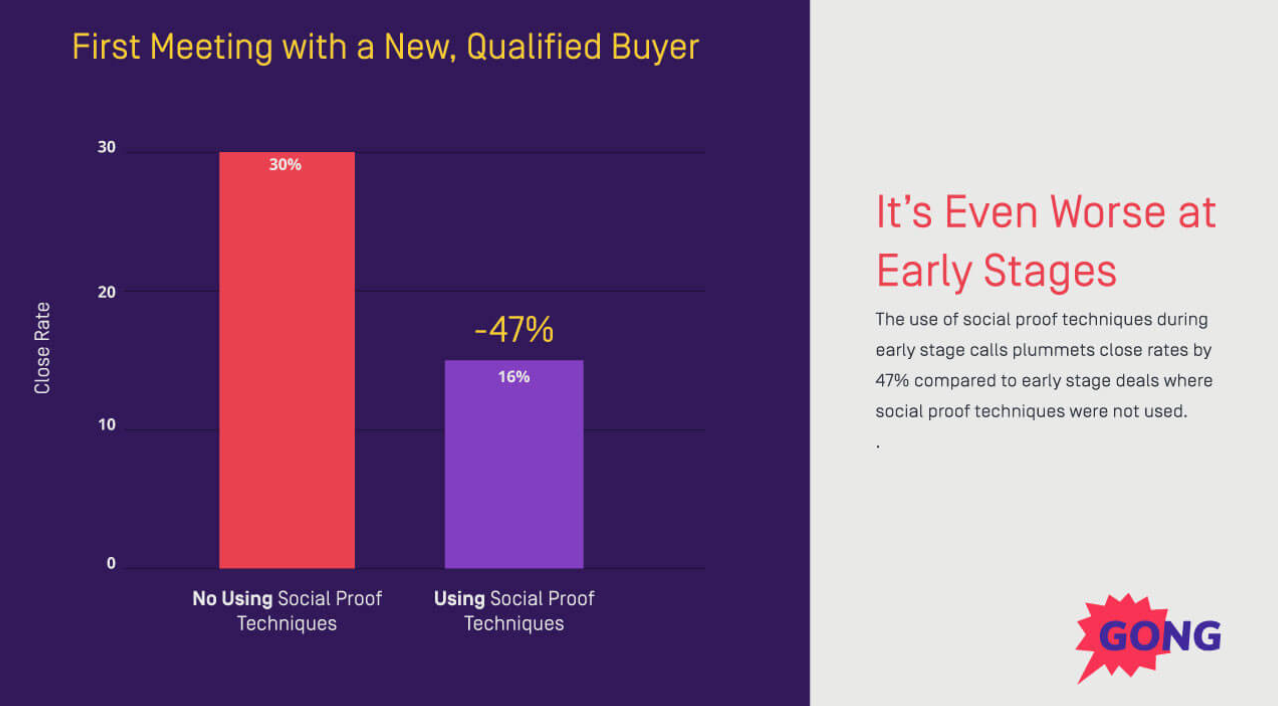
Listing 2-3 mega-companies is the WRONG WAY to go (unless you’re selling to a mega-company). It makes buyers feel like your product is for other types of customers than them.
Instead, your social proof should convince buyers you cater to their tribe. Their pain points.
How do you do that?
List a minimum of 5-7 same-tribe customers, not big-name monoliths. If you’re a stellar sales professional working for a rockstar company, you’ll be able to list half a dozen or more.
And if you name a customer from a different tribe, it’s critical that the pain points in the story match your buyer’s.
The whole point is to be sure your buyer sees themselves in the customer story.
Want to learn how to tell customer stories that SELL in detail?
Sign-up for our FREE video training course:
34. Build your business case with customer stories (not ROI calculators)
Ignore this sales tip at your own peril:
- Presenting ROI at any point in the sales process correlates with a 27% drop in close rates.

You’d think that ROI would be a great sales tactic to build your business case, but it’s NOT.
Why?
It awakens the wrong part of your buyer’s brain.
The human brain has two parts: logical and emotional.
Your goal as a salesperson is to stimulate the emotional brain. That’s where buying decisions happen.
When you calculate ROI, you access the logical brain: The part responsible for critical analysis and debate.
That’s why every time you present ROI, your customer argues with your assumptions (best case).
Here’s what to do instead: Tell a before-and-after customer story.
This neutralizes your buyer’s logical brain. It “goes to sleep.” You get to slip your business case in under the radar, cloaked in a narrative. As you tell your story, include the metrics as a detail of the before-and-after.
The key to getting this right is showing both the before and after. Most salespeople forget the “before.”
Buyers perceive value in the contrast between before and after.
Here’s a slide from one of our business case decks so you know what this looks like.

The beauty of this approach is there are no assumptions for your buyer to argue with! You’re just telling a story. If that story resonates, your job becomes easier.

35. Establish value before you talk price
The best sales reps know that the order of what they talk about in a sales call matters to winning a deal.
Take, pricing, for example. According to our data, the best salespeople don’t discuss pricing until the end, after they’ve shown value:

How do you make sure that happens? What if your buyer is CLAMORING to talk price early in the sales call?
Well, kids, an ounce of prevention is worth a pound of cure.
START your call with an agenda that sets expectations that you’ll discuss pricing at the END of the meeting.
“Here’s what I planned on covering: We’ll talk about A, B, and C. At the end we’ll cover pricing and if it makes sense, the next step. Does that work for you Mrs. Prospect?”
BOOM.
Use that agenda-setter, and you can say goodbye to premature pricing discussions.
36. Find a weakness in your competitor’s strength
Here’s a sales-judo technique to help you CRUSH your competition.
Most salespeople focus on their competitor’s weaknesses. But it’s more important to know how to topple their STRENGTHS.
If you point out your competitor’s weaknesses, your competition can refute or correct them.
BUT! If you show how your competitor’s STRENGTHS make their product a poor fit for your buyer, you’re gonna make bank.
Here’s an example:
It’s 1985. Burger King has encroached on McDonald’s market share and the two are in a heated marketing battle.
Burger King realizes that McDonald’s strength is their positioning as the place for KIDS. Think Happy Meals, the ‘Play Place’ structures, and Ronald. Everything about McDonald’s was kid-oriented.
BK’s genius spin was to promote themselves as the place for GROWNUPS. The place where you could get a robust burger instead of fun food.
Figure out your competitor’s strengths and use them against them.
It’s sales-judo.
37. Solidify your positioning early on
Want to know a Gong-exclusive secret?
Competitors HELP you win deals.
According to our data, when you discuss competitors EARLY in the sales process, you’re more likely to win the deal than if your competitors weren’t discussed at all:

Winning your competitive battle is best done during your FIRST sales pitch.
If you wait until the end of the sales process, you’re stuck between a rock and a hard place.
The point?
Competitive deals are good … If you win early.
If you’re a sales manager, your call to action is simple.
Get involved in competitive deals early on. Don’t wait until the final hour, when buyers have crystallized their preferences.
Get alerts from Gong.io as soon as deals become competitive so you can help your rep WIN:

As soon as your reps or buyers mention competitors in a sales meeting, you’ll get an alert in your inbox.
Instead of your competition flying under the radar, you’ll know about every competitive conversation. Don’t let them go unchecked:

Relish the competition, but take them out early.
And remember the sage advice from Geoffrey Moore, author of Crossing the Chasm:

If you position early, you set the “lens” that your buyer uses to evaluate both you and your competitors.
Objection handling tips for salespeople
GREAT prospecting techniques? Check.
FLAWLESS discovery calls? Check.
EPIC sales presentation tactics? Check.
Nice work.
BUT… we’re not done yet. It’s time to get nitty gritty with objection handling.
This is MASSIVELY important. You can have great sales skills in every other area, but if you fumble through objections, you’ll lose a lot of deals.
Read these objection handling technique tips to keep your deals progressing smoothly.
PS: Become an objection handling master. Watch our FREE Objection Handling Master Class video here:
38. Pause and speak with a calm authority
The best salespeople pause after objections.
In fact, they pause for longer after an objection than during other parts of a sales call.

It’s as if objections trigger them into slow motion.
By contrast, unsuccessful reps often interrupt the customer upon receiving an objection. They pounce on objections, getting “all riled up.”
They also speak faster after hearing an objection. It’s as if objections make them nervous.
Consider this: In a typical sales call, average talking speed is 173 words per minute.
But when flustered by an objection, a bad sales rep will speed up to 188 words per minute.

Top producers slow down.
If you maintain calmness during a flurry of objections, you’ll build trust.
The rest of the sales techniques and tips won’t matter if you can’t do that.
39. Clarify objections with questions
This next sales tip might surprise you (but it makes total sense).
According to our data, GREAT salespeople respond to objections with a question:

Objection handling scenarios are rife with misunderstanding. Without clarifying the CAUSE of an objection, you might address the wrong issue. So asking questions makes sense.
Average salespeople don’t bother with this step though. They respond to objections with a KNEE-JERK monologue that looks like this:

The customer voices a valid concern, and the sales rep spends the next minute steamrolling.
Not only do they often address the WRONG issue, but talking for long streaks reeks of insecurity.
What question should you ask to clarify objections?
The first one is ‘mirroring’. This sales tactic is from Chris Voss in his book Never Split the Difference.
Here’s how it works: Repeat the last few words of your buyer’s sentence. And do it with an upward voice tone (like you’re asking a question). It triggers your buyer to elaborate.

The key is to PAUSE and let your buyer further explain.
Now here’s a warning. Ignore at your own peril.
Don’t ask “why?” when clarifying objections. “Why” doesn’t clarify. It’s a threatening question that questions the validity of the buyer’s objection. It puts your buyer on the defensive.

That leads us to the second type of question you can use to clarify objections.
Can you help me understand what’s causing that concern?
Notice this question asks “why” without uttering the word “why.”
SNEAKY RIGHT!?
To sum up, overcoming an objection is like peeling an onion. The core of the onion is what you want to address.

You have to peel back the outer, surface-level layers.
40. Validate the objection
Here’s your second technique in the objection handling process. After you’ve clarified the objection with a question, VALIDATE your buyer’s concern.
We already discussing making your buyer feel understood earlier. We won’t rehash why this sales technique is so important here.
Here’s how to do this during objection handling: Tell them they have a valid concern. Then label the emotions you’ve observed them express:

“That’s a valid concern, Sean. It seems like you’re torn on what to do here.”
That’s empathy on STEROIDS.
And again, if you get this right, it might be the first time in their lives that your buyers have felt truly understood by another person.
41. Isolate the objection
This is something that I still find a lot of salespeople do wrong.
Before you address an objection, you have to be sure you’re tackling the right objection.
People often express one objection, while concealing their TRUE concern. Your job is to make sure that’s not happening, and if it is, to UNEARTH the real problem.
Once you’ve followed the previous steps, here’s how you isolate the objection:
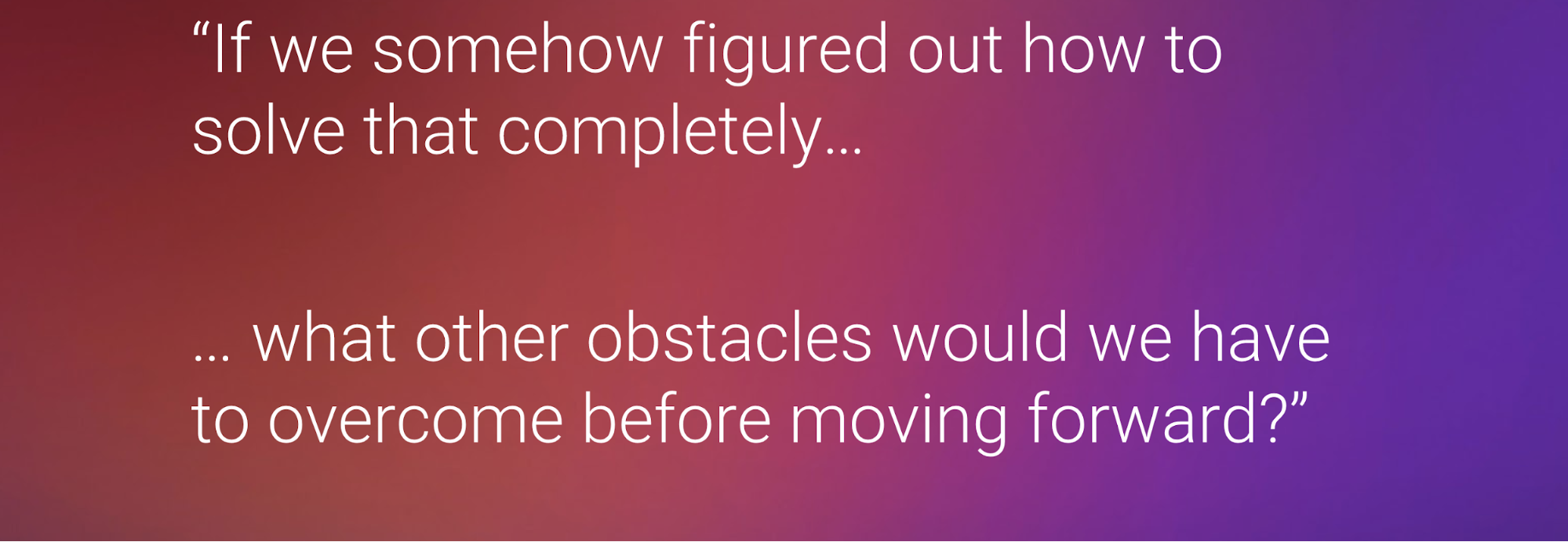
If your buyer voices other objections, chances are those are the REAL things you need to overcome.
If they don’t have any others, then the first objection they voiced is the right one.
Congratulations, you’ve isolated the objection :)
42. Get permission to address the objection
You’ve followed the last three techniques. You’ve:
- Clarified with a question
- Validated the concern
- Isolated the objection
GREAT.
Now before jumping in headfirst, get your buyer’s permission to introduce a new way of thinking.
It’s as simple as asking this:
“Can I bounce a few thoughts off you?”
This question NEUTRALIZES your buyer’s mind and makes them receptive to a new way of thinking.
Don’t ask this question in attempting to gain permission:
“Can I make a suggestion?”
This question triggers defensiveness. Your buyer might act the part, but deep down, they will not be receptive to whatever you say next. They’ll anticipate a lecture, pretend to listen, smile, nod, and ultimately be on a different page than you.
Stick with the less threatening “Can I bounce a few thoughts off of you?” It makes YOU the vulnerable person in the interaction, not the buyer.
43. Address the objection with a reframe
If you’ve done the last five tactics, you can now address the objection with a “reframe.”
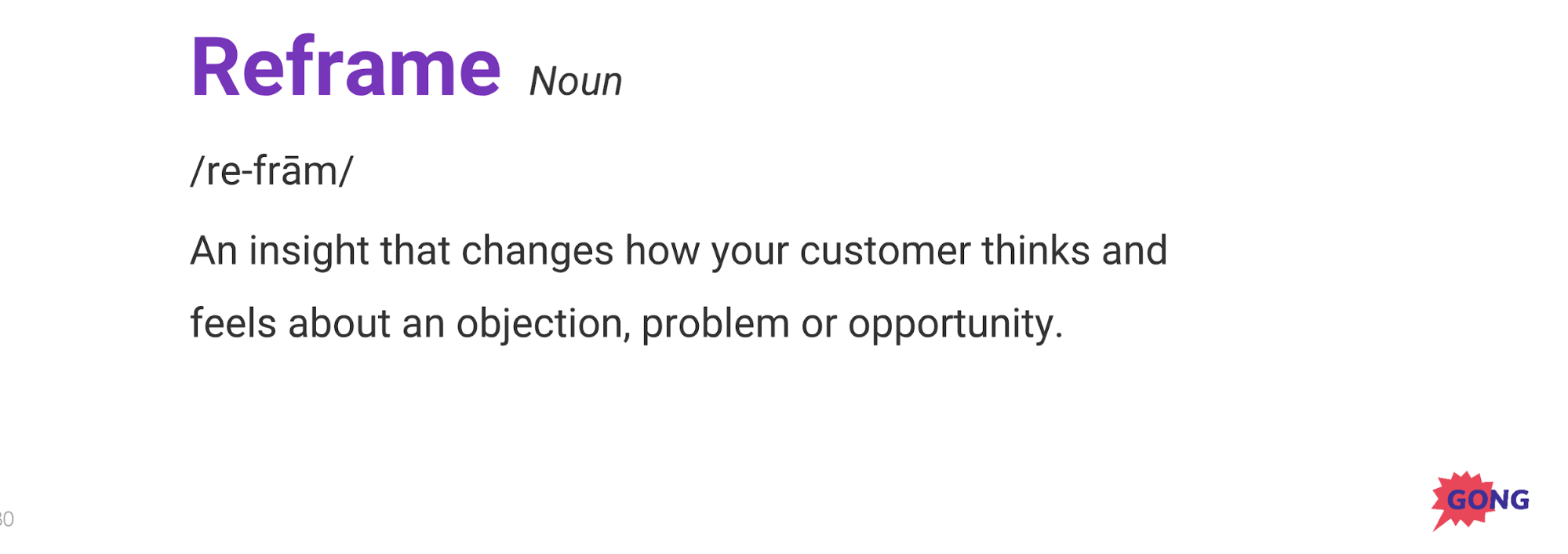
Reframes get your buyer will see things through a new “lens.”
Here’s an example.
(NOTE: This example would not work without the previous steps. Without that padding, this is a trite argument. But with the previous steps, and with your buyer’s permission, it will change the way your buyer thinks).
Here at Gong.io, we try to get our buyers to pilot our software. And an objection we often face is this:
“I don’t want to start a pilot until after next month. We’re too busy closing out the quarter. Right now is the worst time to for us to do this.”
We’ve trained our salespeople to reframe that “poor timing” objection:

Stumped at coming up with your OWN reframes?
Think of a common objection you’re currently struggling with.
Got it? Now ask these questions about it:

Ask those questions, and you’ll come up with some great reframes.
44. Confirm resolution in an UNBIASED way
Don’t LEAD the buyer to say what you want to hear. This leaves the objection unresolved, killing your deal later on.
Here’s a sales tactic to bring closure to the objection:

The exact phrasing of this question matters.
You DON’T want to say something like “Does that resolve your concern?”
That might lead your buyer to give you a false “yes.” And remember: Objections buried alive never die :) They come up later as killer zombies.
Now, if your buyer responds with “no, we can move on,” CONGRATS! You’ve overcome the objection!
Grow your objection handling skills. Take your skills to the next level.
The Objection Handling Master Class is FREE and now available. Watch the free master class here:
Want more quick tips on objection handling to share with your team? Here’s the Gong.io Objection Handling Training Deck:
Closing sales techniques
AHHHHH!
We’ve made it to the end of the sales process and it’s time to get PAID!
Now listen: If you’ve done everything right up to this point, closing is a NON-EVENT.
I repeat: closing is a non-event if you’ve done everything else right!
You can’t manipulate a B2B buyer with slick sales techniques into closing. The earlier part of the sales process has to work for a close to happen.
That said …
You still need to CLOSE (which is more so decisiveness than some slick closing sales tactic you read on the Interwebz).
Here are some great sales techniques and sales tips for wrapping your deals.
45. Secure “next steps” with this phrase
Talking about NEXT STEPS doesn’t just move you through a sales process, it moves you through it faster.
See the tiny green dot below? It’s where the salesperson discussed next steps, right at the end, where you’d expect:

In the FASTEST SALES CYCLES, the salesperson spent 53% more time discussing next steps:

And just as importantly, they had that discussion that ON THE FIRST CALL. That’s the optimal time to raise the issue, and it has a deep impact on close rates.
Unfortunately, 26% of salespeople miss these steps completely on their first call:

The result? Their close rates DECLINE by an astounding 71%:

This is an easy fix: Have a ‘next steps’ conversation on your first call.
Here’s the best “closing line” I’ve ever seen for securing next steps at the end of a sales meeting:
“Based on what you’ve told me, the next step is _________.
What obstacles do we need to remove before we get started?”
The second line preps you to make a solid close, and we talk about how to do that in our next sales technique tip.
46. Don’t ASK for the close. Suggest it.
Our data science team at Gong.io has shown time and again that most closing techniques are dead. (Don’t believe it? Read our post about why “Closing Technique Tips in Sales Are Dead.”)
Manipulation, pressure, and pushy tactics are a thing of the past. They’ll aggravate your buyer and drive them away.
So what can you do instead? What gets the buyer over that final hurdle to sign?
LEADERSHIP.
You need to lead your buyer toward the finish line and cross it with them.
They’ll have emotional hurdles at this point in the process — that’s natural. It’s up to you to be their rock, providing reassurance and stability.
They’re going to raise concerns. Embrace them. Handle them with calmness, moving them toward the close.
Show your buyers that you’re committed to them for the long haul.
Be decisive: make recommendations to help your buyer get from uncertainty to certainty.
Let leadership be your MO.
LEAD and CLOSE.
Miscellaneous sales techniques and tips
Not everything in sales fits nicely into neat little boxes (ahem, categories).
BUT that doesn’t mean those things aren’t important!
So, here are a few miscellaneous sales techniques and tips you shouldn’t ignore.
47. Say “approved pricing” (not “list pricing”)
This is our easiest quick-fix sales tip ever.
NEVER say “list price,” “typical price,” or “standard price” again. It’s shocking how destructive those words are. If you say them at any point in your deal, your sales cycle will take 19% longer than average:

That’s an extra 12 days on a 60-day cycle! Ouch.
Here’s another painful stat: Saying “list price” on either of your first two sales calls in a sales process, TRIPLES the time you spend discussing pricing later on:

Instead, say APPROVED PRICE.
It makes the buyer believe the price is set, resolute, and unmovable.
It signals that there’s a higher power than you who sets the pricing, and “they’ve” already determined what’s possible and reasonable.
Your buyer will understand that the pricing won’t change easily, and they’ll be more reluctant to negotiate.
For more tips on the right words to use during pricing discussions, download our “Pricing Cheat Sheet”:
48. Schedule your sales calls for the right time
You’ve landed a sales meeting, and you’d better believe that WHEN you schedule that call matters.
Booking a call for the right time ups your chances of it going well.
Most sales professionals book meetings in the morning. That’s when the prospect is awake and ready to go, right?
Not so much.
Prospects are less likely to ditch and bail on you in the afternoon. No-shows are such a pain. They extend your sales process, so you want to avoid them at all costs.
Stick with afternoon bookings. They have higher attendance rates and they LAST LONGER:
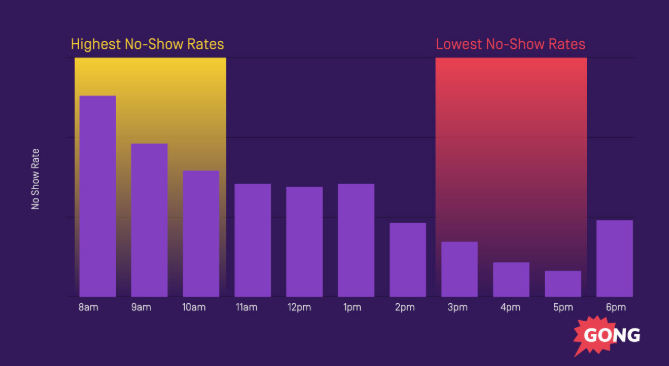
Mornings are the worst.
Your prospect is 30% more likely to show up for a call at 4 PM than one at 8 AM.
If you’ve been scheduling meetings at the wrong time, don’t worry, you’re not alone. Most salespeople get it wrong:

Super easy fix. (You’re welcome.)
49. Use downward voice inflection (most of the time)
There’s nothing as annoying as teenagers who end every sentence like it’s a question. You know exactly what I mean. I bet you could even do a brilliant impression of it.
I’m sure you don’t sound like that on sales calls. BUT you might not be aware of how often that high-note inflection creeps into your speech.
It’s so damaging when it does. It steals every ounce of your authority … rips it right out from under you.
Your client LOSES RESPECT for you.
High-note inflection a signal that you’re looking for approval. You’re making statements that sound like questions, hoping that your prospects will approve of what you’re saying.
It reeks of desperation.
Instead, end your sentences (questions too!) with a downward or neutral tone.
Strike a balance though — be careful you don’t sound authoritative or domineering. If you can achieve that perfect balance, buyers will see you as a high-status person.
That’s exactly how you want them to see you: as powerful and persuasive.
The only time you SHOULDN’T do this is when you’re using the mirroring technique we talked about earlier. If you use that technique, you’ll mirror a questioning tone back to your buyer when they raise objections.
Otherwise, conjure your inner Oprah. (A master of this technique.)
50. Ask your manager to join your sales call
This sales tip holds a record at Gong.io for its outstanding capacity to boost close rates.
Imagine one act increasing your close rate by 258%.
Have a sales team member (sales manager) join you for team selling for precisely that effect:

It’s such an impressive metric that your entire team is going to want to do it all the time. (We recommend doing it early in the sales process, so it’s not a last-ditch effort to bring a buyer back around.)
If sales team members or managers find they’re stretched and hopping onto too many calls, save this sales technique for your most important deals.
51. Use a voice that commands respect
This one’s a lot like our earlier voice sales tip, though it’s about more than downward inflection. It’s about your overall VOICE.
Respect is something you can command in subtle ways through your voice. It’s a sales technique you can master.
If you had to imitate a junior salesperson and then a high-powered executive, what would you do differently? You’d adjust your body posture, and then you’d make majors changes to how you use your VOICE.
A junior rep’s voice usually conveys an insecure, approval-seeking personality. EXECUTIVES use their voices to demonstrate authority and strength.
Drop your sales pitch, slow your talking speed, and use a tone that’s calm, warm, and confident.
Final sales techniques, tips and free templates
Okay, let’s wrap this up.
Here are a few final tips to keep you ahead of the evolving landscape of sales techniques going forward…
52. Learn as much as you can
Knowledge is power.
There are SO many great sales books and amazing sales blogs offering free advice, so learn as much as you possibly can.
Subscribing to the Gong Blog is a good start:
[newsletter title=”Grow Your Skills” call=”Get insanely effective sales tips sent to your inbox.”]
And once you’ve done that, check out our Resources Library. It’s PACKED with some of the world’s most valuable sales techniques and sales tips:
Download IT ALL!
53. Avoid shady sales techniques and cheesy sales tactics
If a sales technique takes away your fuzzy-wuzzy happy feelings, let that be a warning. Trust your gut because there are plenty of slimy sales techniques out there.
Do yourself a favor: Skip the trash.
Your buyers want an authentic professional who has their best interests in mind.
54. Implement new sales techniques FAST
THIS is the number one thing that separates the world’s HIGHEST-EARNING salespeople:
Speed of implementation
That’s the length of time between when they LEARN something new and TRY it in the real world. It’s SHORT for the world’s highest earners.
They understand that all the knowledge in the world is useless until they use it to CHANGE OUTCOMES.
And that’s the point here: improving close rates. You have 50-something sales tips and techniques in your back pocket, so start using them!
If that seems overwhelming, pick one and try it on your next sales call. Promise yourself you’ll add at least one sales technique per week to your routine. You’ll see a massive change in your numbers.
True story.
55. Be proud you’re in sales and constantly experiment with new sales tactics
If you’re anything like the folks here at Gong.io, you’re ADDICTED to everything SALES.
We know you have other tools and – and sales templates – up your sleeve.
Got any cool sales techniques or tips you’d like us to add to this list?
Leave us a comment and we’ll consider adding it!
[newsletter title=”Grow Your Skills” call=”Get insanely effective sales tips sent to your inbox.”]









